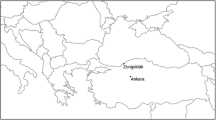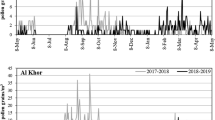Abstract
Platanus pollen is considered as a major cause of pollinosis in many southern European cities. This tree is commonly used in parks, avenues and gardens as ornamental species. The flowering period is short and abrupt between March and April, since this tree is characterized by having fast and explosive blooming process. This fact induces an important public health problem when Platanus bloom. The objective of the study is to evaluate the pollen and allergen concentration in two cities in the north-west of the Iberian Peninsula, Porto (Portugal) and Ourense (Spain), and analyse how weather parameters and environmental pollutants can affect the patterns of pollen and allergen airborne distribution. The pollen sampling was conducted, during 2018, using a Hirst volumetric sampler, and Pla a 1 aeroallergen was collected using a Burkard multivial cyclone sampler. The pollen counting was obtained following the Spanish Aerobiology Network methodology. Aeroallergens were quantified by ELISA method using a Pla a 1-specific antibody. Platanus pollen concentrations are seven times lower in the Porto atmosphere than in Ourense, but the Pla a 1 content is only 2 times higher in Ourense city. These differences can be explained by the influence of air pollutants in plants and meteorological factors. Platanus airborne pollen and Pla a 1 aeroallergen were correlated with some meteorological parameters, namely temperature, rainfall and relative humidity, and with atmospheric pollutants such as NO2 and O3. The results suggest the existence of different allergenic activities in the atmosphere of both cities.




Similar content being viewed by others
References
Aina, R., Asero, R., Ghiani, A., Marconi, G., Albertini, E., & Citterio, S. (2010). Exposure to cadmium-contaminated soils increases allergenicity of Poa annua L. pollen. Allergy, 65(10), 1313–1321.
Aira, M. J., Rodríguez-Rajo, F. J., Fernández-González, M., & Jato, V. (2011). Airborne pollen of ornamental tree species in the NW of Spain. Environmental Monitoring and Assessment, 173, 765–775.
Alcázar, P., Cariñanos, P., De Castro, C., Guerra, F., Moreno, C., Domínguez-Vilches, E., et al. (2004). Airborne plane tree (Platanus hispanica) pollen distribution in the city of Córdoba, South-western Spain, and possible implications on pollen allergy. Journal of Investigational Allergology and Clinical Immunology, 14(3), 238–243.
Alcázar, P., Galán, C., Torres, C., & Domínguez-Vilches, E. (2015). Detection of airborne allergen (Pla a 1) in relation to Platanus pollen in Córdoba, South Spain. Annals of Agricultural and Environmental Medicine, 22(1), 96–101.
Andersen, T. B. (1991). A model to predict the beginning of the pollen season. Grana, 30, 269–275.
Arilla, M. C., Eraso, E., Ibarrola, I., Algorta, J., Martínez, A., & Asturias, J. A. (2002). Monoclonal antibody based method for measuring olive pollen major allergen Ole e 1. Annals of Allergy, Asthma & Immunology, 89, 83–89.
Arilla, M. C., González-Rioja, R., Ibarrola, I., Mirw, A., Monteseirínz, J., Condez, J., et al. (2006). A sensitive monoclonal antibody-based enzyme-linked immunosorbent assay to quantify Parietaria judaica major allergens, Par j 1 and Par j 2. Clinical and Experimental Allergy, 36, 87–93.
Armentia, A., Lombardero, M., Callejo, A., Barber, D., Gil, F. M., Martin-Santos, J., et al. (2002). Is Lolium pollen from an urban environment more allergenic than rural pollen? Allergol Immunopathology, 30(4), 218–224.
Asturias, J. A., Ibarrola, I., Bartolome, B., Ojeda, I., Malet, A., & Martínez, A. (2002). Purification and characterization of Pla a1, a major allergen from Platanus acerifolia pollen. Allergy, 57, 221–227.
Asturias, J. A., Ibarrola, I., Eraso, E., Arilla, M. C., & Martínez, A. (2003). The major Platanus acerifolia pollen allergen Pla a 1 has sequence homology to invertase inhibitors. Clinical and Experimental Allergy, 33, 978–985.
Azizi, M. H. (2011). Impact of traffic-related air pollution on public health: A real challenge. Archives of Iranian Medicine, 14(2), 139.
Bousquet, J., Schünemann, H. J., Bousquet, P. J., Bachert, C., Canonica, G. W., Casale, T. B., et al. (2011). How to design and evaluate randomized controlled trials in immunotherapy for allergic rhinitis: An ARIA-GA(2) LEN statement. Allergy, 66(6), 765–774.
Buters, J. T. M., Weichenmeier, I., Ochs, S., Pusch, G., Kreyling, W., Boere, A. J. F., et al. (2010). The allergen Bet v1 in fractions of ambient air deviates from birch pollen counts. Allergy, 65(7), 850–858.
Cecchi, L. (2012). Introduction. In M. Sofiev & K. Bergmann (Eds.), Allergenic pollen: A review of the production, release, distribution and health impacts (pp. 1–8). Berlin: Springer.
Charpin, D., Calleja, M., Lahoz, C., Pichot, C., & Waisel, Y. (2005). Allergy to cypress pollen. Allergy, 60, 293–301.
Cortegano, I., Civantos, E., Aceituno, E., Del Moral, A., Lopez, E., Lombardero, M., et al. (2004). Cloning and expression of a major allergen from Cupressus arizonica pollen, cup a3, a PR-5 protein expressed under polluted environment. Allergy, 59(5), 485–490.
D’Amato, G., Cecchi, L., Bonini, S., Nunes, C., Annesi-Maesano, I., Behrendt, H., et al. (2007). Allergenic pollen and pollen allergy in Europe. Allergy, 62(9), 976–990.
Feng, M., Lu, S., Zhang, R., Shen, C., Huang, J., & Wang, Y. (2011). Preliminary studies on complex pollution caused by ambient allergenic pollens and urban particulate matters in Shanghai. China Environment Science, 31(7), 1095–1101.
Fernández-Caldas, E., Carnés, J., Iraola, V., & Casanovas, M. (2007). Comparison of the allergenicity and Ole e 1 content of 6 varieties of Olea europaea pollen collected. Annals of Allergy, Asthma & Immunology, 98, 464–470.
Fernandez-Gonzalez, D., Gonzalez-Parrado, Z., Vega-Maray, A. M., Valencia-Barrera, R. M., Camazon-Izquierdo, B., Nuntiis, P. D., et al. (2010). Platanus pollen allergen, Pla a 1: Quantification in the atmosphere and influence on a sensitizing population. Clinical and Experimental Allergy, 40(11), 1701–1708.
Fernández-González, M., Guedes, A., Abreu, I., & Rodríguez-Rajo, F. J. (2013). Pla a_1 aeroallergen immunodetection related to the airborne Platanus pollen content. Science of the Total Environment, 463–464, 855–860.
Fernández-González, D., Rodríguez-Rajo, F. J., González-Parrado, Z., et al. (2011). Differences in atmospheric emissions of Poaceae pollen and Lol p 1 allergen. Aerobiologia, 27, 301–309.
Galan, C., Antunes, C., Brandao, R., Torres, C., Garcia-Mozo, H., Caeiro, E., et al. (2013). Airborne olive pollen counts are not representative of exposure to the major olive allergen Ole e 1. Allergy, 68, 809–812.
Galán, C., Cariñanos, P., Alcázar, P., & Domínguez, E. (2007). Spanish aerobiology network: Management and quality manual (pp. 1–61). Córdoba: University of Córdoba.
García-Mozo, H., Domínguez-Vilches, E., & Galán, C. (2007). Airborne allergenic pollen in natural areas: Hornachuelos Park, Córdoba, Souther Spain. Annals of Agricultural and Environmental Medicine, 14, 63–69.
Ghiani, A., Aina, R., Asero, R., Bellotto, E., & Citterio, S. (2012). Ragweed pollen collected along high-traffic roads shows a higher allergenicity than pollen sampled in vegetated areas. Allergy, 67(7), 887–894.
Hirst, J. M. (1952). An automatic volumetric spore trap. Annals of Applied Biology, 39, 257–265.
Hong, M. J., Kim, D. Y., Lee, T. G., Jeon, W. B., & Seo, Y. W. (2010). Functional characterization of pectin methylesterase inhibitor (PMEI) in wheat. Genes & Genetic Systems, 85(2), 7–106.
Li, J., Li, Y. C., Zhang, Z., Li, Y., & Wang, C. Y. (2018). The dispersion characteristics of airborne pollen in the Shijiazhuang (China) urban area and its relationship with meteorological factors. Aerobiologia, 34(1), 89–104.
Lu, S., Zhang, R., Yao, Z., An, J., Zhong, Y., Wu, M., et al. (2011). Physicochemical characterization and cytotoxicity of ambient coarse, fine, and ultrafine particulate matters in Shanghai atmosphere. Atmospheric Environment, 45, 736–744.
Majeed, H. T., Periago, C., Alarcón, M., & Belmonte, J. (2018). Airborne pollen parameters and their relationship with meteorological variables in NE Iberian Peninsula. Aerobiologia, 34, 375–388.
Martínez-Cortizas, A., & Pérez-Alberti, A. (1999). Atlas Climático de Galicia. In X. de Galicia (Ed.), Santiago Compostela (pp. 77–105).
Maya-Manzano, J. M., Fernández-Rodríguez, S., Monroy-Colín, A., Silva-Palacios, I., Tormo-Molina, R., & Gonzalo-Garijo, A. (2017). Allergenic pollen of ornamental plane trees in a Mediterranean environment and urban planning as a prevention tool. Urban Forestry & Urban Greening, 27, 352–362.
Mimet, A., Pellissier, V., Quénol, H., Aguejdad, R., Dubreuil, V., & Rozé, F. (2009). Urbanisation induces early flowering: Evidence from Platanus acerifolia and Prunus cerasus. International Journal of Biometeorology, 53(3), 287–298.
Miranda, P., Coelho, F. E. S., Tome, A. R., & Valente, M. A. (2001). 20th century Portuguese climate and climate scenarios. In F. D. Santos, K. Forbes, & R. Moita (Eds.), Climate change in Portugal. Scenarios, impacts and adaptation measures—SIAM. Executive summary and conclusions (1st ed., pp. 23–84). Lisbon: Gradiva.
Moreno-Grau, S., Elvira-Rendueles, B., Moreno, J., García-Sánchez, A., Vergara, N., Asturias, J. A., et al. (2006). Correlation between Olea europaea and Parietaria judaica pollen counts and quantification of their major allergens OLE e 1 and Par j 1–Par j 2. Annals of Allergy, Asthma & Immunology, 96, 858–864.
Norris-Hill, J. (1998). A method to forecast the start of the Betula, Platanus and Quercus pollen season in North London. Aerobiologia, 14, 165–170.
North, M. L., Alexis, N. E., Ellis, K., & Carlsten, C. (2014). Air pollution and asthma: How can a public health concern inform the care of individual patients? Annals of Allergy, Asthma & Immunology, 113(4), 343–346.
Oteros, J., Buters, J., Laven, G., Röseler, S., Wachter, R., Schmidt-Weber, C., et al. (2017). Errors in determining the flow rate of Hirst-type pollen traps. Aerobiologia, 33(2), 201–210.
Pazouki, N., Sankian, M., Leung, P., Nejadsattari, T., KharvariNejad, R., & Varasteh, A. (2009). Identification of cyclophilin as a novel allergen from Platanus orientalis pollens by mass spectrometry. Journal of Bioscience and Bioengineering, 107(2), 215–271.
Ribeiro, H., & Abreu, I. (2014). A 10-year survey of allergenic airborne pollen in the city of Porto (Portugal). Aerobiologia, 30, 333–344.
Ribeiro, H., Costa, C., Abreu, I., & Esteves da Silva, J. C. G. (2017). Effect of O3 and NO2 atmospheric pollutants on Platanus x acerifolia pollen: Immunochemical and spectroscopic analysis. Science of the Total Environment, 599–600, 291–297.
Sabariego Ruiz, S., Gutiérrez Bustillo, A. M., Cervigón Morales, P., & Cuesta, P. (2008). Forecasting airborne Platanus pollen in the Madrid region. Grana, 47, 234–240.
Sedghy, F., Sankian, M., Moghadam, M., Ghasemi, Z., Mahmoudi, M., & Varasteh, A. R. (2017). Impact of traffic-related air pollution on the expression of Platanus orientalis pollen allergens. International Journal of Biometeorology, 61, 1–9.
Sturm, A., & Tang, G. Q. (1999). The sucrose-cleaving enzymes of plants are crucial for development, growth and carbon partitioning. Trends in Plant Sciences, 4(10), 401–407.
Suárez-Cervera, M., Castells, T., Vega-Maray, A., Civantos, E., del Pozo, V., Fernández-González, D., et al. (2008a). Effects of air pollution on Cup a 3 allergen in Cupressus arizonica pollen grains. Annals of Allergy, Asthma & Immunology, 101(1), 57–66.
Suárez-Cervera, M., & Seoane-Camba, J. A. (2005). Biología celular del polen: Origen y función de los alérgenos polínicos. In A. L. Valero Santiago, & A. M. Cadahía García (Eds.), Polinosis II: Polen y Alergia. SL and Loboratorios Manarini SA (in Spain).
Suárez-Cervera, M., Vega-Maray, A., Castells, T., Rodríguez-Rajo, F. J., Asturias, J. A., Le Thomas, A., et al. (2008b). An approach to the knowledge of pollen and allergen diversity through lipid transfer protein localization in taxonomically distant pollen grains. Grana, 47, 272–284.
Takahashi, Y., Ohashi, T., Nagoya, T., Sakaguchi, M., Yasu-eda, H., & Nitta, H. (2001). Possibility of real-time measurement of an airborne Cryptomeria japonica pollen allergen based on the principle of surface plasmon reso-nance. Aerobiologia, 17(4), 313–318.
Tipping, M. E., & Bishop, C. M. (1999). Probabilistic principal component analysis. Journal of the Royal Statistical Society B, 61, 611–622.
World Allergy Organization. (2013). The WAO white book on allergy. In R. Pawankar, G. W. Canonica, S. T. Holgate, R. F. Lockey, & M. Blaiss (Eds.), Wisconsin, USA: World Allergy Organization (p. 20).
Acknowledgements
National Funds through FCT – The Portuguese Science and Technology Foundation for the project PTDC/ATP-EAM/0817/2014 and Scholarship (SFRH/BDP/125686/2016) of M. Fernández-González, and (SFRH/BDP/103934/2014) of H. Ribeiro. Institute of Earth Sciences (ICT) funds, under contract with (UID/GEO/04683/2013 (POCI-01-0145-FEDER-007690)) FCT and FEDER through the Operational Program Competitiveness Factors – COMPETE.
Author information
Authors and Affiliations
Corresponding author
Rights and permissions
About this article
Cite this article
Fernández-González, M., Ribeiro, H., Pereira, J.R.S. et al. Assessment between Platanus pollen and Pla a 1 allergen in two cities of North-western Iberian Peninsula. Aerobiologia 35, 463–475 (2019). https://doi.org/10.1007/s10453-019-09576-0
Received:
Accepted:
Published:
Issue Date:
DOI: https://doi.org/10.1007/s10453-019-09576-0




